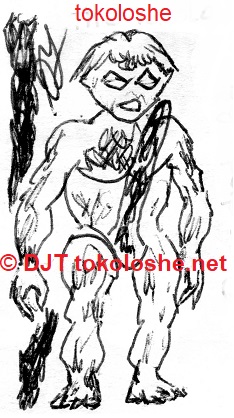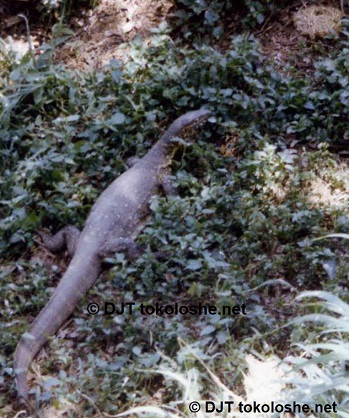The Tokoloshe
|
The tokoloshe, also spelled tokolosh, tikoloshe or thokolosi, is a small, hairy, anthropoid creature in Southern African folklore. According to Eric Rosenthal, the tokoloshe has a tail. I have not read about the tail in any other description of the tokoloshe but I have a high regard for Rosenthal's authority. (I hope that "tail" was not a euphemism for the tokoloshe's manhood, which is slung over the goblin's shoulder so that it does not drag on the ground.)
An early writer on the subject of the tokoloshe was the author A. Brigg. In the nineteenth century, he wrote that the existence of the tikoloshe (sic) or hili is a belief among the Fingoes, a South African tribe related to the Xhosa. The tokoloshe, he recounted, is "about two feet high, but very stout and strong ...". He also wrote that the tokoloshe "lives in a beautiful house of many rooms at the bottom of the river, where he has gardens and large flocks and herds." According to Brigg, the tokoloshe rides an iguana, by which he certainly meant the Nile monitor lizard, Varanus niloticus, also called the water monitor lizard or, in South Africa, water leguaan or likkewaan.
It can grow to over two meters in length. This one I photographed in 1986, on the bank of the Sabie River, next to Skukuza rest camp of the Kruger National Park. It was investigating a large nest and I estimated its length to be about six feet, the largest I had ever seen. I did not see a tokoloshe on its back but they are invisible to adults. In spite of its subaquatic flocks, herds and gardens, the tokoloshe enters people's homes and steals food. If anyone awakens in the presence of the tokoloshe, wrote Brigg, "a mist comes before their eyes, so that they cannot see him." However, it is sometimes glimpsed while escaping with its booty towards the river, where its reptilian getaway vehicle awaits. Other sources state that the tokoloshe can be seen by some children and that sangomas (South African shamans) have the power to make tokoloshes visible and even bind them into service. Sangomas usually serve a benevolent purpose, unlike witches, who may use tokoloshes for evil purposes. According to the author and sangoma Credo Mutwa, the father of all tokoloshes was Za-Ha-Rrellel or Sareleli, the Emperor of the First People. The mother of all tokoloshes was Watamaraka, the Goddess of Evil. However, elsewhere in the text, Credo Mutwa also wrote that the physical father of the tokoloshes was a strange being called the Burumatara, an elephant-sized chimera with the head of a bull and the tail of a crocodile. It was the Burumatara that mated with Watamaraka. Whether Credo Mutwa meant that Za-Ha-Rrellel was the adoptive father of all tokoloshes, or that Za-Ha-Rrellel and the Burumatara were one and the same, or whether they are separate and conflicting legends, is not clear to me from the text. I am inclined to think that Credo Mutwa did NOT intend to convey distinct and conflicting legends, as his intention was to convey a single story and belief system, using his considerable knowledge of Southern African religions, beliefs, mythology, history and ethnology. Some authors state that the tokoloshe is mischievous but not usually very dangerous, unless it has been dispatched by a witch or renegade sangoma on a malevolent mission. However, Rosenthal wrote that the tokoloshe is said to "lurk in rivers where young people pass, and to drag them into the water." A. Brigg, mentioned previously, was in agreement on that point. Many a young messenger, he found, could not be persuaded to work at night if the journey involved crossing a stream, "for fear that the tikoloshe should catch him ...". Rosenthal recorded another story that emphasised the connection between the tokoloshe and rivers and streams. A Cape cart crossing a river in Umtata was being pulled by a horse called Tikoloshe. It sat down midstream and a Xhosa man had to carry the driver, one Mrs Welsh, to safety. Her rescuer told her that the owner of the horse had been foolish to disrespect the water god by naming a horse after it. IcantiNot that consciously avoiding rivers, streams or pools guarantees safety from a watery and supernatural demise. Brigg also wrote that "Some of the interesting tribes of South Africa have a singular belief in the existence of a power residing in the streams and rivers, which they call Icanti." Icanti calls to people wherever they are and whatever they are doing. Their work or conversation will be suddenly interrupted and they will go into a sort of trance and walk or run towards the river. Nobody but the intended victim can hear the call. If Icanti is merciful, the person called will sacrifice an animal and throw the meat into the river, otherwise he or she will enter the river and drown or disappear forever. Sometimes, the victims friends succeed in stopping him or her from committing apparent suicide. If so, an animal sacrifice, as described above, may satisfy Icanti. If someone manages to resist Icanti's call but does not offer a suitable sacrifice, something very bad will happen to him or her, e.g. he or she will fall victim to disease. Since tokoloshes are also feared water spirits, it seems that Icanti is an especially powerful tokoloshe, one that can no doubt resist the power of sangomas to bend it to their service. Tokoloshe and ChildrenThe attitude of the tokoloshe towards children appears to be ambiguous. Rosenthal recorded a case that took place in Pondoland in 1906. A farmer came across four herdboys who sat entranced with terror on their faces. He asked them what was the matter. His voice jolted them to their senses but instead of answering him, they fled. The father of one of the boys later thanked the farmer, explaining that they had been under the spell of a tokoloshe and that they had been in great danger. On the other hand, the tokoloshe allows some children to see it and even play with it. Mrs Welsh, mentioned earlier, recounted to Rosenthal another story, one that she had heard from a trusted friend. Two of her friend's brothers often played with the tokoloshe at night. It allowed them to play catch with a round stone that made them invisible when they held it. The boys would not say who they were playing with until daylight, however, as talking about the tokoloshe at night may cause the speaker to be slapped by small, invisible hands. The friend herself saw a tokoloshe in the "location" (a residential area reserved for black people) of De Aar (a railway junction in the Karoo). She was sixteen at the time and it saw her but ignored her, apparently concentrating on some more important matter. That tokoloshe was wearing a cape of animal skin and its yellow eyes reflected the moonlight. More About the TokolosheIn South Africa, black people living in cramped quarters, especially servants, sometimes raised their beds on bricks. Some people think that this was, and perhaps still is, done to place the sleeper out of reach of tokoloshes. However, that is untrue, as I explain in the article The Real Reason That Maids Raised Their Beds on Bricks. Tokoloshes may be related to melon heads and Catskill gnomes: Are Tokoloshes Melon Heads? You can read more about the tokoloshe on the website www.vanhunks.com: The Tokoloshe. |
COPYRIGHT DJT tokoloshe.net © April 2019 : No material on this site may be copied by any means, without the author's permission.
African Ghost Hunting Safaris
Camelopard Travel Advice
Gentleman Adventurer
Shanghai Cafe China Website
Gentleman Adventurer in Space


